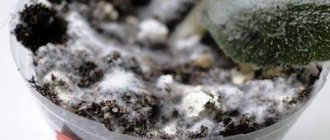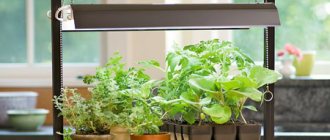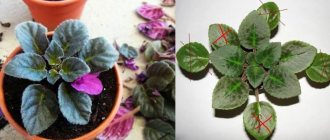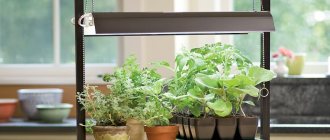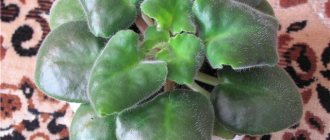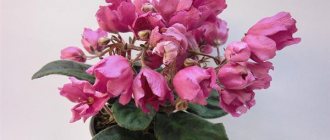Most indoor plant lovers place their green “pets” on the windowsill. If you prefer violets, then the window sill is precisely the most unfavorable place for growing this type of flower. In summer, direct sunlight can leave burns on the leaves of Saintpaulia. In winter, they may be exposed to hot, dry air generated by radiators. Another threat to Saintpaulias is the cold, which inevitably penetrates even through the most insulated window.
Favorable conditions
When choosing a good place to grow Saintpaulia, the best solution is shelves or special racks with lighting. You can even use a regular cabinet. All you need is to provide your favorite indoor plants with proper lighting , which will allow them to achieve the highest degree of decorativeness. This is quite simple to do; you just need to fix the lamps above the flowers at a distance of at least 20 centimeters. Thus, the optimal distance between racks or shelves should be at least 55 centimeters.
The plants themselves should be positioned so that the outer leaves of neighboring Saintpaulias do not touch. Moreover, the number of lamps directly depends on the depth of the shelf and its size. Florists recommend installing shelves whose depth will be approximately 50 centimeters. Another important condition is the width of the shelves for growing Saintpaulias, thanks to which it will be convenient for the owner of this type of indoor flowers to turn the pots on different sides to the light to ensure full photosynthesis.
It is worth considering the features of the lamps you will use. As a rule, a strong flow of light is concentrated in the middle of the lamp, and at its edges it is weaker.
For this reason, plants with dark green leaves should be placed closer to the center of the rack, as they absorb more light than plants with pale green foliage.
About shelving and artificial lighting for Saintpaulias
Moderator: Floriana
About shelving and artificial lighting for Saintpaulias
Post by elena65 » 08 Nov 2011, 20:20
About shelving and artificial lighting for Saintpaulias
Elena, I have another question for you: have you or anyone you know tried Aqua lamps for aquariums and plants. It is very bright, I have one on a shelf 44 cm wide and I see that the leaves on some rosettes seem to fade. So I’m thinking - maybe it’s not suitable for violets.
Re: About shelving and artificial lighting for Saintpaulias
Post by Elena M. » 08 Nov 2011, 23:07
Re: About shelving and artificial lighting for Saintpaulias
Post by Yalo » 08 Nov 2011, 23:21
Re: About shelving and artificial lighting for Saintpaulias
Post by svet-lana1 » 09 Nov 2011, 09:38
Re: About shelving and artificial lighting for Saintpaulias
Post by Elena M. » 09 Nov 2011, 10:22
Re: About shelving and artificial lighting for Saintpaulias
Post by elena65 » 09 Nov 2011, 12:20
Re: About shelving and artificial lighting for Saintpaulias
Post by Yalo » Nov 10, 2011 10:24 am
Re: About shelving and artificial lighting for Saintpaulias
Post by Vera » November 10, 2011, 01:54 pm
Re: About shelving and artificial lighting for Saintpaulias
Post by Yalo » 10 Nov 2011, 21:08
Re: About shelving and artificial lighting for Saintpaulias
Post by Svyatoslav » November 10, 2011, 21:13
Re: About shelving and artificial lighting for Saintpaulias
Post by Elena M. » November 11, 2011, 00:09
Re: About shelving and artificial lighting for Saintpaulias
Post by Mihail M » 11 Nov 2011, 01:19
Re: About shelving and artificial lighting for Saintpaulias
Posted by Yalo » Nov 11, 2011 10:21 am
Growing Saintpaulias with lighting
Post by elena65 » 06 Dec 2011, 17:45
Re: About shelving and artificial lighting for Saintpaulias
Post by Yalo » 06 Dec 2011, 19:56
Backlight Features
One of the most common problems that violet lovers have to face is the lack of sunlight. Lack of lighting can lead to the following consequences:
- growth slowdown;
- lack of flowering;
- poor development.
To avoid the above potential problems, it is necessary to resort to additional illumination of the plant. LED strips are perfect for this function. It is recommended to choose a tape whose color spectrum will be cool shades, and the power will not exceed 25 watts per 1 meter.
It is necessary to resort to LEDs on cloudy days or when the sun does not shine in the direction where the flowers are located.
Consider also the fact that for the rapid development of violets, up to 14 hours of daylight are needed. The LED should be turned on several hours before sunset. This feature allows you to use additional light if your plants are located on a window sill. This type of lighting will not cause discomfort to the eyes and will create comfort in the home.
Another type of lamp that could serve as additional lighting is a fluorescent lamp. If your plants are located not on the windowsill, but on a shelf, then just such a lamp will be convenient to use. The strength of such a lamp is its ability to evenly distribute light over a fairly large radius, which other types of lamps cannot boast of. As a rule, fluorescent lamps are placed above the flowers at a short distance. Most often, most people choose this option.
And yet, experts recommend using LED strips at home.
How does a lack or excess of light affect the growth and development of a plant?
Whether violets need light, they themselves will tell you with their appearance:
- if the young leaves develop well and the flower stalks rise above the rosette, then the violet has enough light ;
- elongated petioles, too thin leaf blade, leaves pointing upward, the violet stops growing and blooming - a sign of insufficient light ;
With a lack of light, the leaves begin to stretch.
- in good light, the leaves of variegated varieties are brightly colored;
- the leaves fall down, over the edges of the container, the color is light, with a yellowish tint, the petioles are shortened, the rosette is thickened - long daylight hours (more than 14 hours);
- short peduncles, pale color and smaller flowers, short flowering period - excess light.
A fly in the ointment, or completing an experiment with LEDs.
So, six months have passed since the installation of the rack with LED lighting. We can summarize. And in my case they are disappointing. Violets suffer monstrously from lack of light. Thanks to this rack, I almost threw out my entire collection (thank you, it got warmer and some of the violets moved to the windows). No matter what I did - I increased and decreased the daylight hours, raised and lowered the sockets, nothing helped! All my rosettes stretched out wildly, turned pale and began to dangle in the pots, like... um... Milky Way in an ice hole. And in order not to be unfounded, I’ll show you photos
Growing temperature
Violet is a heat-loving flower. The optimal ambient temperature, comfortable for its cultivation, should be in the range of 20 – 25 °C. If in the summer, during flowering, the temperature tends to 30 °C, the violet will suffer from overheating. Its flowers will become smaller, the color of leaves and flowers will fade, and varietal features in the form of variegated foliage and a bright border will disappear. Use all the temperature-reducing devices you have - air conditioning, split system, fan, or ventilate the room.
But violets do not like sudden changes in temperature, cold drafts and scorching rays of the sun. They should be protected from this. In winter, the air temperature should be about 20 °C. (strictly not lower than 16 °C).
Reminder for a newbie!
Uzambara (Uzumbar) violet is a plant of the Gesneriaceae family, growing in the natural environment of tropical and subtropical regions of Asia, Africa, Eastern Australia, South America and the Indian Ocean islands.
Saintpaulia is a plant named after the Saint-Paul father and son, who brought a plant unknown to Europeans from the Uzambara district (modern Tanzania) in the 19th century, presented for the first time at the international flower exhibition in Ghent in 1893.
Indoor violet has been one of the most popular plants in indoor floriculture since 1927. By 1949, more than 100 varieties had been bred, and today their number exceeds several thousand.
Rooting
- possibly in water, in substrate, moss.
Priming
- purchased soil or a mixture of leaf, coniferous, turf and peat soil in a ratio of 3:1:2:1 with the addition of raising agents (perlite, vermiculite, river sand, crushed sphagnum moss.
Lighting - it is best to place flower pots on western or eastern windows. To ensure that the plant is evenly illuminated from all sides, the pots are periodically rotated. In winter, when daylight hours decrease, you can use artificial lighting - fluorescent lamps.
Caring is a real art and serious painstaking work at the same time, including watering, fertilizing, and creating a favorable humid climate. Water Saintpaulias as the soil dries. The soil must be moistened regularly, but excess moisture should not stagnate in the roots. When watering, you must ensure that water does not get on the leaves. You cannot water the Uzambara violet with cold water. Fertilizing is done with complex mineral fertilizer once every two weeks. Saintpaulia reacts negatively to a lack of nitrogen in the soil. Optimal air humidity is approximately 50%, temperature is 20-22 ° C, without sudden fluctuations and drafts. The leaves of the plant should not touch the window glass. Removal of faded flowers and damaged leaves is carried out regularly.
Reproduction - planting a leaf cutting, part of a leaf, or a daughter rosette. The most popular method is rooting leaf cuttings. The formation of roots and the development of children lasts 4-8 weeks.
Pests are one of the gardener's problems. There are many different types of pests and it is very difficult to classify them. Among Saintpaulia pests, several groups can be distinguished: mites (spider mites, flat mites, transparent mites, etc.), insects (aphids, thrips, springtails, poduras, scale insects, whiteflies, scale insects, etc.), worms (nematodes).
Diseases - distinguish between infectious (gray rot, powdery mildew) and non-infectious diseases (rotting of the stem and root, wilting of the lower leaves, yellowing, leaf spotting, incomplete opening and premature drying, falling of flowers) of plants. The causative agents of infectious diseases are bacteria, fungi, and viruses. To prevent infectious diseases, you should strictly observe the regimes of watering, temperature, humidity, and lighting. Non-communicable diseases usually arise due to poor agricultural practices. They may appear in one instance and not spread to others.
Many people like to grow home decorative plants, but not everyone has space on windowsills and near windows so that the flowers can receive daylight.
Here we will discuss such a topic as lighting for violets: which lamps are best to use, how long to illuminate these delicate and very sensitive flowers. Saintpaulia is capricious, and if it is not provided with the proper conditions for existence, then it will refuse to grow and delight you with its amazingly beautiful flowers.
Protection from diseases
Violet diseases can develop due to many reasons: improper care, errors during transplantation.
Most common diseases
| Diseases | Protection |
| Root rot is the result of activation of fungi, improper watering, and temperature violations. Weak seedlings and flowers are susceptible to damage in winter. Signs: violet wilting. | Maintaining the optimal temperature for Saintpaulia, correct placement in the room, or treating with chemicals will not help. Only radical measures - removal from the ground and renewal of the soil. |
| Powdery mildew - is formed due to fungi that affect the upper and lower parts of Saintpaulia, petioles and buds. Signs: the appearance of a white coating. | Treatment with fungicides, timely weeding and timely application of fertilizing, which will strengthen the immune system and increase the level of resistance, are suitable as protection. |
| Rust is also a product of a fungus that causes leaf damage, curling and turning it dark brown. Multi-colored tubercles appear on the underside of the leaf. | Protective measures include tilt treatment and removal of affected leaves. |
How much light does a violet need?
Saintpaulia uzumbarica (indoor violet) needs a luminous flux of at least 10, and preferably 12 hours a day. The rest of the time she should be in peace and darkness. The plant is a light-loving plant, but along with this fact, it cannot tolerate the scorching sun.
If the violets stand in direct sunlight in hot weather for more than 2 hours, their leaves will begin to burn: yellow or brown spots will appear, the plant will begin to wither and wither.
If flower pots are kept away from the window, Saintpaulia may look quite healthy, but may not bloom for a long time. This means that it does not have enough light intensity to activate processes that can only be synthesized at a certain level of radiation.
When it is impossible to arrange Saintpaulia plants in a room so that they receive the proper amount of light, they must be provided with artificial lighting.
Organization
If flowers are grown in a dark room, the role of selecting the spectrum of the light flux becomes even more important, since the lamp becomes the main and only source of light for flowers placed in such growing conditions. The speed of development and duration of the growing season of Saintpaulia will depend on your use of the spectrum.
If there is no daylight in the room where violets grow, you should resort to using full artificial lighting. Phytolamps will help you cope with this. Thanks to their purpose, they emit the necessary colors (red and blue) to completely saturate the plants with light. The power of such lamps depends on their length. Thus, a phytolamp with a length of more than 90-120 cm has a power of 36-40 watts.
If you want to achieve healthy and vibrant color in your violets, then purchasing a wide range of lamps is an excellent solution. Under them, the plants will look great and become neater. In this case, it is better to give preference to German companies. Almost all types of lamps from German manufacturers include a full range of spectra. The main characteristic feature of such lamps is the ratio of the shades of the rays.
Illumination for violets, what to use
There are many different lighting options for indoor plants. The most suitable lamps for violets are fluorescent.
It is most practical to choose such lamps of standard sizes: 26 mm in diameter and 59 cm in length. The average power is suitable - 30 W. Although for young plants you can use 18 W.
The radiation of one standard fluorescent lamp is enough for an area of approximately 1 m². Hang the lamp at a height of 20-25 cm from the violet bushes. It is advisable that the lamp shines from above, and not from the side.
For better light dispersion, you can use reflectors (foil, mirrors).
You need to turn on the artificial light source for violets for 12 hours. Some people use special switches with a timer, when the lamp goes out and comes on at the same time automatically, which is very convenient.
LED strips are also effective. They are convenient to attach to any surface in any position. In addition, they are very energy efficient. The only negative is their cost, which is quite high.
If you are seriously passionate about growing Saintpaulias and grow them not only for yourself, but also for sale, then backlit racks for violets would be an excellent solution. The lamps are immediately mounted on the shelves on which the pots are placed.
If you know little about electricity and carpentry, it is better to order such a rack from professionals. Design, size, number of shelves - all this is done at your discretion. When assembling such a structure, it is important to take into account electrical insulation, because the plant will be regularly watered.
Tips for placing violets on racks with lamps
- The optimal height between shelves is 45 cm.
- For varieties of violets that bloom with red flowers, there are special phytolamps that have a specific emission spectrum that allows you to obtain many shades of red. Such lamps are installed as additional ones.
- You need to gradually transfer violets to artificial light: first turn on the lamps for an hour, then increase this time by 15-20 minutes day after day.
- Types of violets whose leaves are dark and denser are best placed in the center of the shelf; they need a little more light.
- The temperature on the upper shelves is always slightly higher than on the lower ones. Place young bushes on top, they will be more comfortable in the warmth.
Do not forget that lighting for violets is the most important condition for their existence. Without light, many processes in the plant will go out, it will not bloom and may soon die. If you have a fairly free meta on the window sills, then try to place Saintpaulia on the server or eastern side.
- Author: Maria Sukhorukikh
Rate this article:
- 5
- 4
- 3
- 2
- 1
(0 votes, average: 0 out of 5)
Share with your friends!
Installation
There are 3 typical mistakes in tape installation.
1. The first is the use of a weaker power supply than is required to power the tape. Then a reduced voltage is applied to the tape and it shines dimly.
2. Another mistake is connecting several tapes one after another, in series. If you bought tapes in reels 5 meters long, then supply separate power to each tape from the power supply. Tape manufacturers cannot make thick conductors on the tape; they are limited to thin conductors. Over 5 meters of length, only residual voltage reaches the LEDs at the end of the strip. As a result, the LEDs at the end of a 5-meter strip shine approximately 1.5 times weaker than the LEDs at the beginning of the strip. If another is attached to one strip, then it will shine approximately 2 times weaker.
It is easier for electricians to power one strip and connect the rest in series. But require them to provide separate power with normal copper wires for every 5 meters of tape (even if it is cut into several pieces and scattered on shelves).
Exception. There are reels with ribbons of 10 meters. Theoretically, the wiring in them is thicker. But it’s still better to mount them so that one branch of the serial power supply contains pieces of tape with a total length of no more than 5 meters.
3. The third mistake is that voltage is supplied to the tapes using ordinary flexible wires for a 220 volt network. But in such wires, power is transmitted due to high voltage, and the current passed is low. LED strips are powered by 12 Volts. They require much thicker wires to carry comparable power. (Whoever has cars, remember how thick the finger-thick wires are that come from the battery or “cigarette lighter”. Although the power of a car battery is less than the power of an iron or electric kettle).
To supply a constant voltage of 12 volts to the strips, buy thicker wires than to a table lamp. The thickness of the section as for an iron or teapot will be normal.
Voltage control
To monitor both errors, a regular DC voltmeter will help. After installation, measure the voltage at the beginning of the strip and at the very last LEDs on the very last connected pieces.
Example. The 180 Watt power supply has 2 strips of 5 meters each connected parallel to each other. Power reserve 25%:
- the output of the power supply shows a voltage of 12.2 Volts
- The power supply is supplied via a standard 2 meter long table lamp wire. Only 10.7 volts of power reaches the beginning of the tape (regular 220 volt wires are thin and designed for low currents)
- at the end of each 5 meter tape the power drops to 9.4 Volts when they are connected in parallel
- if two 5-meter tapes are connected in series, then the first tape begins to heat up, passing through additional current of the second tape. The voltage at the end of the second tape drops to 8.2 Volts.
Although the power supply is selected correctly and produces an honest 12.2 Volts, if the wire for supplying constant voltage to the strips is unsuccessful and 2 strips are connected in series, the voltage on the last LEDs in a 10-meter piece drops by 1.5 times. And with a weak power supply, this voltage could drop up to 2-3 times compared to the calculated one. Which would mean a simultaneous drop in illumination in lux by 2-3 times.
Lamps
I've read all about lighting cute flowers with lamps. The abundance of information only made me even more confused.
The question is how exactly to contact the seller, how to tell what kind of lamp I need? What power to take, in what form.
I have a regular tall table lamp on my desk. Can I replace it with a special lamp?
I hope I explained the question clearly)))
Ira, hello! To a question
On the question of lamps. I’ll tell you which ones I have. When I was getting ready to hang shelves for violets, I also had a question, what kind of lamp would be best to choose for them. I read it, thought about it, came to the store (looked at the prices), and settled on ordinary Camelion fluorescent lamps. I have all the violets under them and everyone is happy: they bloom and grow, and the leaves that take root stand under them. And if a light bulb in a lamp burns out, you can easily buy and replace it.
Thanks for the answer.
Thanks for the answer.
Butterscotch, do you need lamps?
Butterscotch, do you need lamps for the shelf? Or where will you highlight your violets?
I have greenhouses and children
I have greenhouses and babies on the table. I just started working with violets.))) I’m thinking of illuminating them with a table lamp. Here it is.
I just don’t know how to contact the seller, maybe I should give the numbers or model.
Or can you use the usual fluorescent ones that are used in offices and schools?
If you have space and
If you have space and have the opportunity to attach a fluorescent lamp above the table, then I think it will be more useful than the one you showed.
If you decide on a fluorescent one, then you can safely take a lamp - Philips 36W/54-765. These lamps are on my shelf and I am very pleased with them. They are 1.2m long.
Thank you. I wrote down the name
Thank you. I wrote down the model name)))
To be brief, the lamps
To be brief, lamps should be taken with the index 8xx. I'll explain now. Now, if you buy a lamp in a housing (Camelion from the first photo), there is nothing written on the lamp at all, no index. An ordinary Chinese lamp. And therefore it is not clear what is shining there at all, mostly just blue light. But in hypermarkets there is a department with these lamps. These are ordinary hatches. You need to look at Osram or Phillips. This three-digit index will be written on them. They are sold without a case, I say again. You just need to buy a lamp with a housing, then simply replace it with another one.
765 is a two-strip phosphor
865, 840 is a three-strip phosphor.
9xx is a five-band (you won’t need it, it costs exorbitant money)
I won’t tell you what a phosphor is, maybe you can find it yourself on the Internet. Just take 865, this is just a lamp with a predominance of blue in the spectrum. It's better for violets. The price will depend on the length of the lamp itself. 18 W - 60 cm
Pest protection
Pests on house flowers occur due to frequently open windows, buying new flowers that do not undergo quarantine, temperature violations and infected soil. Most often Saintpaulia affects:
| Pests | Protection |
| Aphids are almost transparent or black-greenish insects that breed in large groups. As a rule, young leaves and buds are affected. Leads to the death of the plant, tissue necrosis and deformation of the usual leaf shape. | If there are not many insects, remove them with tweezers or your hands. If they completely cover the bush, then spray it with a solution of laundry soap or a mixture of Agricola against pests. |
| Spider mites look like small packs that actively move along the leaves. They instantly cover the entire Saintpaulia, causing the formation of a silvery coating and drying out of the plant. | Since the cause, as a rule, is hot weather, spraying with plain water is suitable as a preventative measure. If preventive measures do not bring results, treat the bush with insecticides. |
| Thrips is a yellowish insect with an oblong body. Its size is quite small, but it can easily destroy a violet bush. Signs are the appearance of brown spots, excessive drying of leaves. | As an experiment, you can try treating it with ash (but it’s a folk remedy and ineffective), and to get 100% results, only insecticides are suitable. |
Viola garden
The plant belongs to the violet genus. Unlike pansies, garden viola reaches a height of 30 cm. It blooms very profusely and for a long time. Flowers perceive shade better than bright sun. In sandy soil the flowers can be very small. Water the plant as needed, but try not to water too much.
If diseases occur, gardeners recommend spraying the plant with a solution of calcium and soda.
With proper care, each of the plants can be grown indoors or in the garden. Plants that are similar to violets are usually not too demanding and can be grown even by amateur gardeners.
What else can they call it?
It is found all over the world. What types of violets are there? Annual and perennial. The most common:
- swamp: usually grows in swamps;
- fragrant: grows in gardens and parks, rare;
- pubescent: can be found in forests and fields;
- field: grows in fields;
- amazing: grows in oak forests.
Other names for the plant are Saintpaulia or Uzambara violet. This decorative leaf plant has a poorly developed root system. The leaves are usually green. The color of Saintpaulia flowers comes in blue, violet and purple shades, which is why it is sometimes called tricolor.
Note! To determine whether a flower has enough light, you need to examine its leaves: if they look up, then there is not enough light, respectively, if down, there is enough light.
Methods for propagating Saintpaulia
For the safety of other indoor plants, it is better to propagate Saintpaulia yourself than to purchase it in gardening stores. This reduces the risk of developing diseases and pests. It takes too long to propagate by seeds; we bring to your attention the most popular options.
Propagation by cuttings
For a fully formed violet that has budded at least 1-2 times, it is necessary to cut off the upper part of the trunk so that a section of the trunk no more than 5 cm remains under the lower leaves. Next, lower the cutting into water and cover it with a transparent bag or film. Increased humidity will help roots form faster.
Dividing the bush
Most Saintpaulias form several rosettes as they grow. Each of them can form a full-fledged bush. To do this, remove the violet from the pot and carefully separate one rosette from the other. It is necessary to make sure that each shoot has its own roots, otherwise it will die. The separated parts are ready for transplanting into the ground and do not require special preparation for this.
Leaf separation
From Saintpaulia, tear off the strongest leaf with a cutting of at least 2 cm. Make transverse cuts on the cutting so that the cutting does not break off and remains intact. Immerse in a glass of water and cover with film (optional). Carefully monitor the condition of the leaf and as soon as several roots are formed, replant it in the ground. If part of the cutting remains on the violet, cut it off, otherwise fungal and viral diseases may become active.
